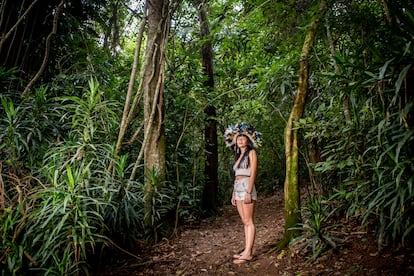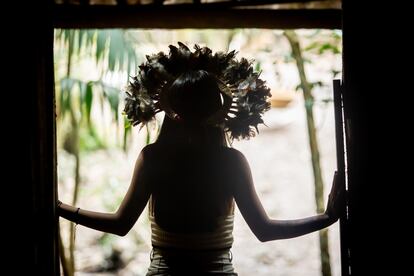The activism of Txai Suruí: From the Amazon jungle to the halls of power
At 25 years old, Txai Suruí is the most well-known Brazilian environmental activist in the world. Her unique power lies in her ability to move between worlds — from government palaces in Europe, to indigenous villages in the rainforest, to the sprawling cities of urban Brazil and the algorithms of social media.


When she travels by plane, Txai Suruí almost never packs her headdress in her suitcase, to avoid crushing its elegant feathers. “This one is from a hawk, this one from a parrot, this one from a macaw,” the Amazon-born activist tells me, as she caresses the radiant plumage. Some of the feathers are a rapturous yellow; others deep blue or various shades of brown, all meticulously sewn together. Suruí tells me that in her community, making a cocar — as an indigenous headdress is called in Brazil — is men’s work. The one she wears during our interview has travelled with her halfway around the world, and was given to her by an uncle. Txai Suruí's full name is Walelasoetxeige Suruí, and she is a 25-years-old activist, land defender, environmentalist, and advocate for the rights of indigenous people. At the slightest hint of curiosity from her interlocutors, she sweeps them away to the rich world of a people who have lived in harmony with nature for millennia, and who continue to protect it like no one else.
Suruí likes to keep a full agenda. Just take the example of the few days in January when we asked to schedule an interview: She could fit us in, but first she had to meet with the French Minister of the Environment in Paris, deliver a speech to students at the Paris Institute of Political Studies, return to Brazil to participate in an event in Recife, then fly to the United States for the Sundance Film Festival in Park City, Utah, to present her new documentary, The Territory, which was shortlisted for the Oscars. Suruí was disappointed it didn’t make the final list of nominees, she tells me the day after the Academy Awards, as we sit on a log under a tree in Jaraguá, one of two indigenous reserves located inside the urban limits of the massive Brazilian city of São Paulo.
Suruí carries herself with ease, whether she’s in a village, a jungle, or a city. She’s as attached to her cell phone as she is to her cocar. This is her power, and her charm. In her recent meeting with the French minister, they discussed climate change, money, cows, supermarkets. “He told me that now, with the Lula administration, they’re going to reestablish dialogue on the environment, since before, with Bolsonaro, it was impossible,” she says. “We also discussed questions around financing, because when we talk about the climate crisis, we’re also talking about the fact that rich countries are not fulfilling their commitments to deliver funding to the countries that are suffering the worst consequences. I also told him about a case we took to court, about the 6,000 head of cattle grazing on indigenous land that are being sold to JBS [a Brazilian meat giant], which in turn sells to the Groupe Casino [a French supermarket supplier]. I told him it was a shame that France talks about helping to protect the environment and traditional peoples, yet continues to buy meat produced through the genocide of our people,” she says. For Suruí, the issue is also personal: “Those cows are in my house!”
When I ask Suruí how it felt to be inside the gilded rooms of that French palace, wearing her cocar in front of a European minister in a suit, she smiles and confesses, with a chuckle: “When I went in, my first thought was: all of this gold is ours.”

The daughter of two veteran land defenders in the struggle for indigenous rights, Suruí is the most internationally recognized among the current generation of young Brazilian climate activists. She rose to fame almost overnight, thanks to a two-minute speech she delivered, in English, during the 2021 UN Climate Change Conference in Glasgow, Scotland.
“My father taught me that we need to listen to the stars, to the moon, to the wind, to the animals and the trees,” Suruí tells me, wearing a traditional plumed sun hat and Harry Potter glasses. “The planet is warming, the animals are disappearing, the rivers are dying and our plants are not thriving like they once did.”
The UN chose Suruí to present at COP26 because they wanted an indigenous woman who spoke English. Always a good student, Suruí is now in her last year of law school. Her speeches and protests draw from her own personal experience, the activist ethic she was raised with, and her deep knowledge of legal and policy frameworks. Along with some friends and fellow activists, Suruí took Brazil to court for failing to comply with the Paris Accords. When she was a teenager, her family faced constant threats and often had to travel with a police escort. Today, she continues to receive death threats.
Suruí is the name Brazilian authorities gave to her father’s ethnic group when they first contacted the tribe in the late 1960s. At the time, her father, the activist Almir Suruí, was only a child. “Suruí is the name they gave us, but we call ourselves paiter, which means ‘true people,’” she explains. Txai Suruí's mother, Ivaneide Bandeira Cardozo, known as Neidinha, is a veteran indigenous scholar who has dedicated much of her life to studying a different ethnic group in Brazil, the Uru Eu-Wau-Wau, who had their first contact with the outside world in the 1980s. Neidinha’s daughter knew the jungle before she was born, when her mother carryied her in the womb while conducting field research.
Suruí considers both of these indigenous peoples — the Suruí and the Uru Eu-Wau-Wau — to be family. This is why she says that she was not actually raised between two worlds, but between three: Her father’s village, the indigenous land where her mother does research, and Porto Velho, Rondônia, a city in the southern Amazon, near the border with Bolivia, where she still lives when she’s not traveling or staying at her boyfriend’s house in the Jaraguá indigenous community in São Paulo.
“Life in the city and life in the village are totally different, but people think all indigenous peoples are the same.” Nothing, of course, could be further from the truth. Just look, she says, at the enormous differences between the Suruí and the Uru-Eu-Wau-Wau, with whom she lives: “They speak different languages, they don’t understand each other, they have different worldviews. We have shamans, they don’t. And the Uru-Eu [that’s how she abbreviates them] have the largest indigenous territory in Rondônia, larger than some European countries. They have two million hectares and four villages in voluntary isolation [avoiding contact with other indigenous people and colonial society]. But they suffer a lot of pressure from poachers, illegal loggers... so [the uncontacted] are appearing more and more often. My village, on the other hand, has only 200,000 hectares and there are no isolated tribes. But we are surrounded by farms, and our land is home to the largest diamond deposit in the world. And we have a very serious problem with the evangelical churches because they weaken our culture... They say our culture is the work of the devil. They don’t want us to paint our bodies!”
Sometimes, in addition to wearing the cocar, she paints the delicate lines of the Suruí on her face. Txai grew up bathing in the river and listening to ancestral stories around a campfire (though by that time, there was also a TV in the village), and she still makes the nine-hour drive home to visit, on occasion. But in many ways, Suruí embraces the same lifestyle as most Brazilian woman her age. She has 110,000 followers on Instagram, and without her feathered headdress, she would hardly stand out on the streets of São Paulo were it not for her piercing eyes and striking jet-black mane. The rest — the denim shorts, the crochet top, the flip-flops, the green painted nails, even the skin decorated with indigenous tattoos — could be the uniform of any Brazilian twenty-something.

This is her greatest asset: her ability to move between disparate worlds. For foreigners abroad, she’s the heir to the legacy of Chief Raoní, the first indigenous Brazilian to take his people’s cause to the world stage, when he starred in a popular 1978 documentary, and then later, when the singer Sting helped turn him into a global celebrity, taking the chief on tour to draw attention to the destruction of the Amazon. At the end of last year, Raoní, who is now in his 90s, accompanied a procession of fellow Brazilians to welcome the return of President Luis Inácio Lula da Silva, climbing the steps of the presidential palace to attend the inauguration.
Unlike many European activists, Suruí knows the ravages of the climate crisis from personal experience. As she puts it, her people are suffering both the causes and the consequences: “The causes are deforestation, incursions by poachers, wildfires... we already see all of that across our territory. But there are also consequences, which we feel more and more with the changing climate: It’s getting very hot. The other day, I was talking with my uncle about a medicinal plant that we use not only to treat diseases, but also to heal the spirit. We used to find this plant in the jungle, but not anymore. We grow coffee, bananas, cocoa, we collect chestnuts... and the warming climate has made it harder to grow crops.” Indigenous people of the Amazon also feel the effects of climate change when they leave the forest, when they migrate, when they are displaced to the city: “If we want to study, or move for quality of life, or when we’re expelled from our territories, we end up in the urban peripheries, with no sanitation. And when it rains, everything floods.”
Suruí has been fighting against injustice ever since she was a little girl. Her mother often recounts how, when Txai was just a small child, they were at a protest and suddenly the child disappeared into the crowd. Her mother, worried, began looking franticly for her in the mass of people. Suddenly, she heard her daughter’s voice. Txai was in the front row, megaphone in hand, shouting declarations in favor of kid’s rights.
Now, Suruí works with 25 different indigenous communities in the state of Rondônia, participates in the Brazilian youth activism network Engajamundo, and collaborates with Kanindé, a socio-environmental NGO founded over thirty years by her mother. And every week, she writes a Saturday column for Folha de S. Paulo, one of the most widely read newspapers in the country.
Indigenous people are a minority in Brazil, making up less than 1% of the population and inhabiting 12% of the territory, but they are active and well-organized. This is not a recent development: indigenous groups participated in the rewriting of Brazil’s constitution in 1988, after the fall of the dictatorship. The indigenous writer and movement leader Ailton Krenak marked the historic moment in the country’s collective memory when, dressed in a pristine white suit and delivering a speech in defense of indigenous rights, he painted his face with black jenipapo ink.
For Txai Suruí and most indigenous people in Brazil, the end of the Bolsonaro government represents the end of a nightmare — not that everything was fine before, but things got much, much worse after the far-right candidate rose to power. A retired military officer, Jair Bolsonaro fulfilled his campaign promise to not designate another inch of land to indigenous people or nature preserves. Indigenous rights were ignored, and the official discourse from the president emboldened groups that ruthlessly exploit the Amazon rainforest.
Luiz Inácio Lula da Silva, aware of the political power of symbolic gestures and wanting to distance himself from the legacy of his predecessor, made a different campaign promise: to create the country’s first Ministry of Indigenous Peoples, and to appoint an indigenous person as its head. And he delivered, appointing veteran indigenous activist and politician Sonia Guajajara to head the new ministry.
For Suruí, Guajajara’s appointment and other actions taken or promised by the Lula government represent an official recognition of the role that Brazil’s original inhabitants have played for millennia in stewarding the land and protecting the environment. It is a tribute to the past, and to the resistance to the Bolsonaro government. The Lula administration is sending a strong message to groups that plunder the rainforest, mobilizing a large-scale operation to clamp down on the illegal mining industry in the Amazon, in an area where the Yanomami have been severely impacted.
Suruí has always enjoyed learning and studying. But her first experience of school, when she moved to the city at the age of seven, was one of hostility and discrimination. “I was bullied a lot. Well, it was more like racism. The other kids called me ‘Indian,’ and I didn’t understand, I didn’t know what that was, but I could tell they were trying to offend me. I went home crying, and my mother explained it to me. I have always been very proud of who I am, of my people, of where I come from. And I can’t run from that. First of all, because of my name, because I don’t have a white name.” She tells me about the elaborate ritual her people, the Suruí, have for choosing a name. The person who leads the ritual is usually an aunt, on the father’s side. “She observed me, dreamed about me, and gave me this name, which means ‘intelligent woman,’” Suruí says.
Her mother, Neidinha, was baffled when her little girl came home from school talking about lions. “But we don’t have lions in Brazil!” she told her. “Even today,” Suruí tells me, “our history is told through the eyes of the colonizers. Even though we’re in the Amazon, where so many rivers, cities, and foods have indigenous origins, our history has remained hidden. But I’m the daughter of two activists who have been in the struggle for many years, and they taught me the real history.” Her mother eventually provided Suruí's school with educational material on the native flora and fauna of the Amazon, and on the jaguars — not lions — that roam there.
This is the vision that Suruí works to spread around the world, where people are often more receptive than many of her compatriots in her home state of Rondônia, the most pro-Bolsonaro region in the country. Suruí's father ran in the October parliamentary elections. He lost. But Suruí and her family of activists are hardened, and hard to deter. They know that the battle can be fought on many fronts.
Sign up for our weekly newsletter to get more English-language news coverage from EL PAÍS USA Edition.
Tu suscripción se está usando en otro dispositivo
¿Quieres añadir otro usuario a tu suscripción?
Si continúas leyendo en este dispositivo, no se podrá leer en el otro.
FlechaTu suscripción se está usando en otro dispositivo y solo puedes acceder a EL PAÍS desde un dispositivo a la vez.
Si quieres compartir tu cuenta, cambia tu suscripción a la modalidad Premium, así podrás añadir otro usuario. Cada uno accederá con su propia cuenta de email, lo que os permitirá personalizar vuestra experiencia en EL PAÍS.
¿Tienes una suscripción de empresa? Accede aquí para contratar más cuentas.
En el caso de no saber quién está usando tu cuenta, te recomendamos cambiar tu contraseña aquí.
Si decides continuar compartiendo tu cuenta, este mensaje se mostrará en tu dispositivo y en el de la otra persona que está usando tu cuenta de forma indefinida, afectando a tu experiencia de lectura. Puedes consultar aquí los términos y condiciones de la suscripción digital.
More information
Últimas noticias
Welcome to the post-religion era: The idea of Christianity as the absolute truth has become obsolete
‘I thought you would like it’: The risky sexual practice popularized by TV shows and TikTok
The digitalization of tourism: ‘They promise experiences and gave us the worst possible one’
Mexican peso defies uncertainty with forecasts of a new period of stability in 2026
Most viewed
- Sinaloa Cartel war is taking its toll on Los Chapitos
- Reinhard Genzel, Nobel laureate in physics: ‘One-minute videos will never give you the truth’
- Oona Chaplin: ‘I told James Cameron that I was living in a treehouse and starting a permaculture project with a friend’
- Why the price of coffee has skyrocketed: from Brazilian plantations to specialty coffee houses
- Silver prices are going crazy: This is what’s fueling the rally









































